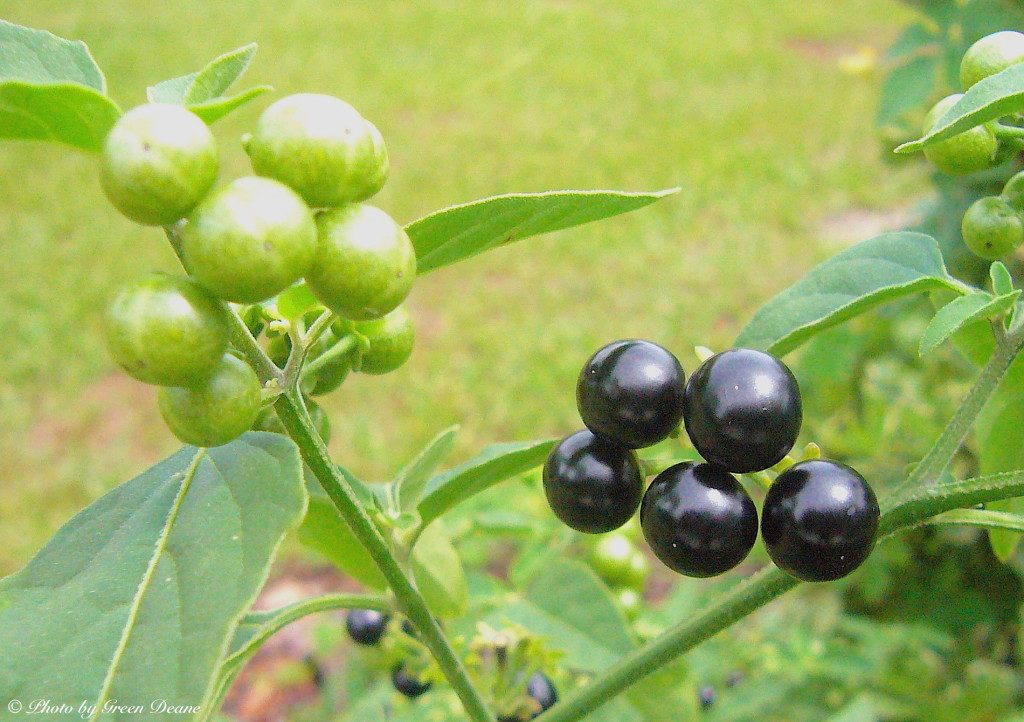
The berries of the much maligned American Nightshade are edible when totally ripe. Photo by Green Deane
The American Nightshade is poised to fruit heavily this year. Everywhere I go teaching foraging classes we are seeing Solanum americanum heavy with (toxic) unripe fruit. When they ripen to edible there will be a lot of them. Perhaps it will be a record crop. While the unripe fruit is not edible the deep purple/black fruit is (unless you have an allergy to the family which also includes potatoes, peppers, eggplant and tomatoes.) The key to this species it to make sure the fruit all originate from one spot on the peduncle (stem) and when green they are shiny, mottled, and flecked with white. Then they ripen into all dark purple berries. To read about them go here.
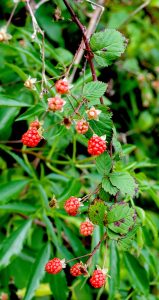
Blackberries are ripening if not already. Photo by Green Deane
In west Orange County a fruiting persimmon tree a yard away from the trim line was cut down. A Suriname Cherry on the other end of the trail went, too. A park I visit often lost a prickly Hercules Club, no doubt because someone complained… Even wild plants have to be tamed. And a huge blackberry patch near where I live was nearly eliminated recently. Too bad for I think they were were cultivated at one time when a house was there and produced heavily. One of the problems of governmental agencies is they often do not communicate about plants even when their focus is plants. Edible plants are removed from parks, toxic plants are used in landscaping at public schools because they’re “native” and a variety of park officers will arrest you for removing a plant they want to removed because it’s an invasive species. In water management areas they will arrest you for catching an edible invasive fish they want to get rid of. It’s not irrational, it’s lack of any comprehensive thorough put between agencies. Thus the blackberries were nearly all wiped out leaving just a few in seasonal wet spots. They seem to be a little late ripening this year. But they are pink now and should be ready in a couple of weeks if not already in some places. Now’s the time to be looking for patches of them so you can harvest later… if the birds don’t get there first. You can read about blackberries here.
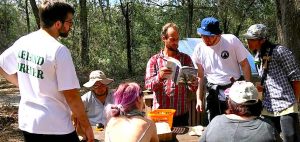
Orlando Mushroom Group meets May 20th
The good news — locally — is that it is April 24th, the last recorded date of a frost in Central Florida. That was about a century and a half ago. We are now seeing a shift from westward coming cold fronts to westward traveling rain and that means mushrooms. That’s a plug for the Orlando Mushroom Group (OMG) which is planning a fugal foray for May 20th. Here’s hoping rain between now and then will make the first hunt of the season fungally fruitful. Put it on your calendar. On the four Facebook mushroom pages I moderate we are getting a few spring postings… sporadic and isolated. That should change if we get weekly rains. I have seen a few Ganodermas making their seasonal run and one Deer Mushroom. Agaricus, Laccaria and False Parasols have been spotted as well. For more information about OMG’s first of the season event go to the group’s page on Facebook. OMG was formed because compared to other states Florida has extremely few mushroom groups that actually meet. We needed one in the middle of the state.
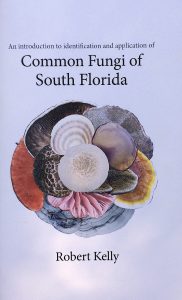
Common Fungi of South Florida
While on the topic of mushroom books about any Florida mushrooms are far and few. This is even more true the further south you go in the state as you leaves the temperate forest behind and approach tropical. Common Fungi of South Florida is a new 54-page paperback just released. It fills a niche for those wondering what fungi to forage for in South Florida. There are at least 80 edible species in the state but the state is some 400 miles long, gets some snowfall at the northern end and never any snow at the southern end. That plus water and soil — or lack there of — all affect what mushrooms will grow where. Written by Robert Kelly the book with color photographs covers some poisonous local mushrooms, entheogenic fungi — read Psilocybe cubensis — a half a dozen edible mushrooms, three medicinals, mushrooms used for dying, and those that help to recycle the landscape. There’s also a useful appendix with glossary, recipes, tree and mushroom associations, description sheet and some basic instruction such as how to create a good spore print. For more information you can contact: thebeginningofthemovement@gmail.com.
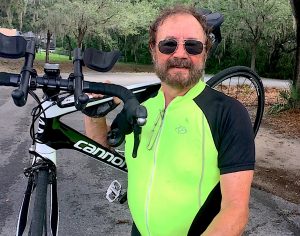
Taking a weekend off to pedal for chairty.
Foraging Classes: While classes have been booked out until June there are no classes this weekend because I’m participating in a Charity Bike Ride in Venice, Florida. I will have this Saturday afternoon free however (April 28th) to look at a local park as a possible future class site. If you have any recommendations in the Venice area please email me. My next classes are in early May, Jacksonville and Melbourne.
Saturday, May 5th, Florida State College, south campus, 11901 Beach Blvd., Jacksonville, 32246. 9 a.m. We will meet at building “D” next to the administration parking lot.
Sunday, May 6th, Wickham Park, 2500 Parkway Drive, Melbourne, FL 32935-2335. Meet at the “dog park” inside the park, 9 a.m.
Saturday, May 12th, Blanchard Park, 10501 Jay Blanchard Trail, Orlando, FL 32817. 9 a.m. Meet at the pavilion east of the tennis courts near the YMCA.
Sunday, May 13th, Bayshore Live Oak Park, Bayshore Drive. Port Charlotte, FL, 9 a.m. Meet at the parking lot across from Ganyard Street.
Saturday May 19th, Eagle Park Lake, 1800 Keene Road, Largo, FL 33771. 9 a.m. Meet at the pavilion near the dog park.
Saturday, May 26th, George LeStrange Preserve, 4911 Ralls Road, Fort Pierce, FL, 34981. 9 a.m.
Sunday May 27th, Dreher Park, 1200 Southern Blvd., West Palm Beach, 33405. 9 a.m. just north of the science center.
Saturday, June 2nd, Red Bug Slough Preserve, 5200 Beneva Road, Sarasota, FL, 34233, 9 a.m.
Sunday June 3rd, Colby-Alderman Park: 1099 Massachusetts Street, Cassadaga. Fla. 9 a.m., meet near the restrooms.
Saturday, June 9th, Blanchard Park, 10501 Jay Blanchard Trail, Orlando, FL 32817. 9 a.m. Meet at the pavilion east of the tennis courts near the YMCA.
Sunday, June 10th, Boulware Springs Park, 3420 SE 15th St., Gainesville, FL 32641. Meet at the picnic tables next to the pump house, 9 a.m.
To learn more about Green Deane’s foraging classes go here.
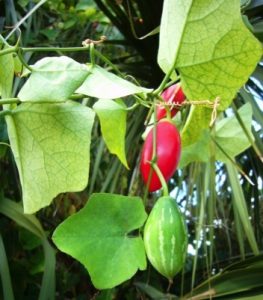
Ivy Gourd fruit ripens to red. Photo by Green Deane
Blossoming now is Ivy Gourd, if it has an established root. There will be fruit in a couple of weeks but they will go through a three-week period of infestation in May. Then for the rest of the year they are mostly insect and maintenance free. Whether it is a “wild food” is a bit of a debate. Ivy Gourd is a constantly re-introduced escaped vegetable, and a fine one at that. Most of the plant is edible and the fruit have two stages. When green they are like a tough-skinned cucumber, then they turn bright red, soft, and full of vitamin A and other red and yellow nutriments. I wouldn’t say my Ivy Gourd is a pet but when I move it moves with me. This time of year I am also over run with a lot of transplantable small roots. Despised by the state and Native Plant Societies it’s a very prolific vegetable and one worth looking for. Eat the fruit, it’s you’re civic duty. You can read more about the Ivy Gourd here.

Green Deane Forum
Want to identify a plant? Looking for a foraging reference? Do you have a UFO, an Unidentified Flowering Object you want identified? On the Green Deane Forum we chat about foraging all year. And it’s not just about warm-weather plants or just North American flora. Many nations around the world share common weeds so there’s a lot to talk about. There’s also more than weeds. The reference section has information for foraging around the world. There are also articles on food preservation, and forgotten skills from making bows to fermenting food. One special section is “From the Frightening Mail Bag” where we learn from people’s mistakes. You can join the forum by clicking on the button on the upper right hand side of this page.
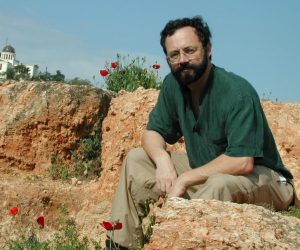
The Nine DVD set includes 135 videos.
Spring orders have started their annual increase. All of Green Deane’s videos available for free on You Tube. They do have ads on them so every time you watch a Green Deane video I get a quarter of one cent. Four views, one cent. Not exactly a large money-maker but it helps pays for this newsletter. If you want to see the videos without ads and some in slightly better quality you can order the DVD set. It is nine DVDs with 15 videos on each. Many people want their own copy of the videos or they have a slow service and its easier to order then to watch them on-line. They make a good gift for that forager you know. Individual DVDs can also be ordered. You can order them by clicking on the button on the top right of this page or you can go here.
 Donations to upgrade EatTheWeeds.com and fund a book are going well. Thank you to all who have contributed to either via the Go Fund Me link, the PayPal donation link or by writing to Green Deane POB 941793 Maitland FL, 32794. Recent upgrades have been paid now the Forum needs work and several function problems need to be fixed specifically the search and categories. A new server also being considered. The other issue is finding an indexing program or function for a real book. Writing programs used to do it automatically if you designated a term for indexing. Now that most books are ebooks most writing programs do not provide and indexing function.
Donations to upgrade EatTheWeeds.com and fund a book are going well. Thank you to all who have contributed to either via the Go Fund Me link, the PayPal donation link or by writing to Green Deane POB 941793 Maitland FL, 32794. Recent upgrades have been paid now the Forum needs work and several function problems need to be fixed specifically the search and categories. A new server also being considered. The other issue is finding an indexing program or function for a real book. Writing programs used to do it automatically if you designated a term for indexing. Now that most books are ebooks most writing programs do not provide and indexing function.
This is weekly issue 301.
If you would like to donate to Eat The Weeds please click here.


Have you ever foraged in SplitOak forest by Moss Park?!
I’ve fetched for American Nightshade everywhere inside my house garden but with no avail . However, not far from home – just a few meters and near a concrete pole where some damp garbage is thrown , l’ve found a gathering of the plant . Some are newly blossoming and others carrying bundles of green fruits. I said “Subhan Allah ” how this coincides with what happens at your side ! Indeed God is Great . Imentioned before that by drying the well ripe dark purple – even black looking for safe edibility – I was able to maintan something excee ding sultanas vis. resins in taste . Sir , I liked the picture and appreciate very much your work on charity . Good luck .
Would love to have some seeds! It’s not invasive here as we don’t have water in the summer and our winters will surely kill it (I am planning on giving it winter protection.)
I’ve read that all ground Ivy is edible. Do you know if that’s true? I have Ivy growing in my yard.